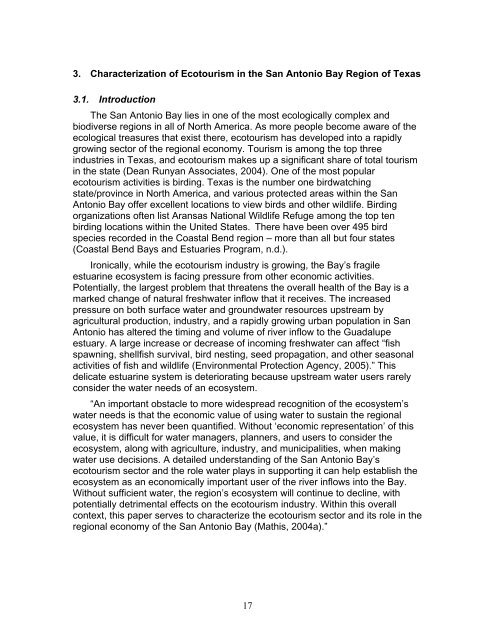The Economic Value of Water and Ecosystem Preservation
The Economic Value of Water and Ecosystem Preservation
The Economic Value of Water and Ecosystem Preservation
You also want an ePaper? Increase the reach of your titles
YUMPU automatically turns print PDFs into web optimized ePapers that Google loves.
3. Characterization <strong>of</strong> Ecotourism in the San Antonio Bay Region <strong>of</strong> Texas<br />
3.1. Introduction<br />
<strong>The</strong> San Antonio Bay lies in one <strong>of</strong> the most ecologically complex <strong>and</strong><br />
biodiverse regions in all <strong>of</strong> North America. As more people become aware <strong>of</strong> the<br />
ecological treasures that exist there, ecotourism has developed into a rapidly<br />
growing sector <strong>of</strong> the regional economy. Tourism is among the top three<br />
industries in Texas, <strong>and</strong> ecotourism makes up a significant share <strong>of</strong> total tourism<br />
in the state (Dean Runyan Associates, 2004). One <strong>of</strong> the most popular<br />
ecotourism activities is birding. Texas is the number one birdwatching<br />
state/province in North America, <strong>and</strong> various protected areas within the San<br />
Antonio Bay <strong>of</strong>fer excellent locations to view birds <strong>and</strong> other wildlife. Birding<br />
organizations <strong>of</strong>ten list Aransas National Wildlife Refuge among the top ten<br />
birding locations within the United States. <strong>The</strong>re have been over 495 bird<br />
species recorded in the Coastal Bend region – more than all but four states<br />
(Coastal Bend Bays <strong>and</strong> Estuaries Program, n.d.).<br />
Ironically, while the ecotourism industry is growing, the Bay’s fragile<br />
estuarine ecosystem is facing pressure from other economic activities.<br />
Potentially, the largest problem that threatens the overall health <strong>of</strong> the Bay is a<br />
marked change <strong>of</strong> natural freshwater inflow that it receives. <strong>The</strong> increased<br />
pressure on both surface water <strong>and</strong> groundwater resources upstream by<br />
agricultural production, industry, <strong>and</strong> a rapidly growing urban population in San<br />
Antonio has altered the timing <strong>and</strong> volume <strong>of</strong> river inflow to the Guadalupe<br />
estuary. A large increase or decrease <strong>of</strong> incoming freshwater can affect “fish<br />
spawning, shellfish survival, bird nesting, seed propagation, <strong>and</strong> other seasonal<br />
activities <strong>of</strong> fish <strong>and</strong> wildlife (Environmental Protection Agency, 2005).” This<br />
delicate estuarine system is deteriorating because upstream water users rarely<br />
consider the water needs <strong>of</strong> an ecosystem.<br />
“An important obstacle to more widespread recognition <strong>of</strong> the ecosystem’s<br />
water needs is that the economic value <strong>of</strong> using water to sustain the regional<br />
ecosystem has never been quantified. Without ‘economic representation’ <strong>of</strong> this<br />
value, it is difficult for water managers, planners, <strong>and</strong> users to consider the<br />
ecosystem, along with agriculture, industry, <strong>and</strong> municipalities, when making<br />
water use decisions. A detailed underst<strong>and</strong>ing <strong>of</strong> the San Antonio Bay’s<br />
ecotourism sector <strong>and</strong> the role water plays in supporting it can help establish the<br />
ecosystem as an economically important user <strong>of</strong> the river inflows into the Bay.<br />
Without sufficient water, the region’s ecosystem will continue to decline, with<br />
potentially detrimental effects on the ecotourism industry. Within this overall<br />
context, this paper serves to characterize the ecotourism sector <strong>and</strong> its role in the<br />
regional economy <strong>of</strong> the San Antonio Bay (Mathis, 2004a).”<br />
17
















